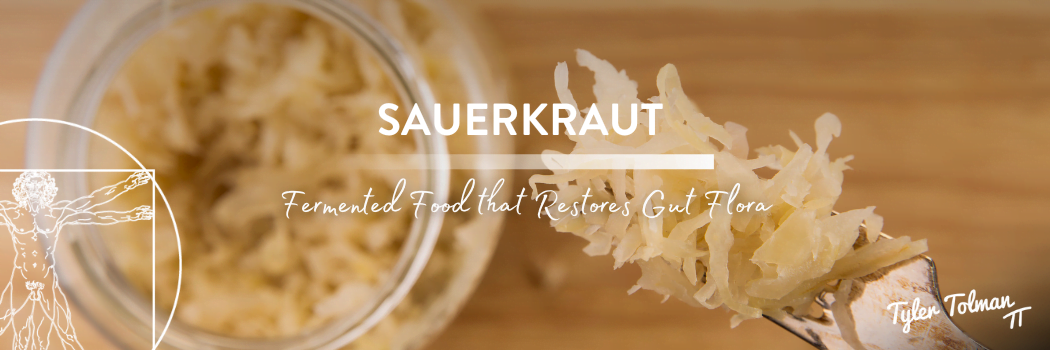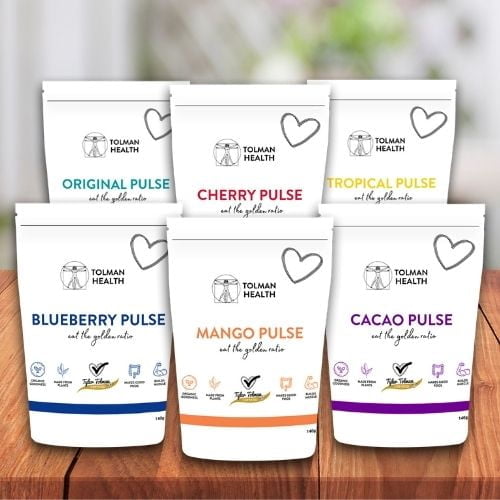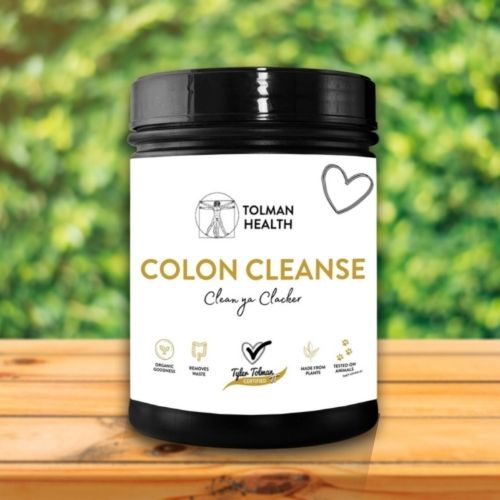TYLER TOLMAN BLOG
Sauerkraut | Fermented Food that Restores Gut Flora

Sauerkraut | Fermented Food that Restores Gut Flora
Sauerkraut contains high levels of glucosinolates. These compounds have been shown to have anti-cancer activity in laboratory research.
Heartburn is an issue for many people. It manifests when stomach acid refluxes back into the esophagus. Unlike our stomach, the esophagus does not have a protective mucosal layer, so the acid burns the esophageal lining which lies in front of our chest. Heartburn becomes problematic when it starts to happen on more than an occasional basis. Gastro-esophageal reflux disease (GERD) is essentially chronic acid reflux and it’s diagnosed through its main symptom – heartburn.
Most people (including doctors) believe heartburn is caused by too much acid, but it’s really just acid winding up in the wrong place (the esophagus). Doctors prescribe acid blockers like Nexium and Prilosec which shut down acid production in the stomach. Though these do provide relief from heartburn, people become dependent upon them because they don’t stop the underlying cause which is so often diet related. Consistently shutting down acid production, which is a totally unnatural thing to do, has consequences!
It never ceases to amaze me how many people today take digestive medications for heartburn. Just take a look at the digestive aide aisle in any drug store. The choices are mind boggling. Really, it’s like standing in the cereal aisle at your supermarket.
It will blow your mind when you see how easy it can be to stop heartburn and GERD with just some simple dietary changes.
Sauerkraut! - For Your Gut
Sauerkraut (as well as other fermented foods like yoghurt, kimchi, kefir and kombucha) is an important component of any digestive health protocol. Properly fermented foods are ALIVE, teeming with billions upon billions of bacteria that populate our digestive tract.
A properly balanced gut microbiome with plenty of the good bacteria and not too many bad ones is essential for good health. The bacteria in our gut affects to many things in our bodies – digestion, metabolism, inflammation and even out mental health!
So when we eat fermented foods, they act as a raft for the good bacteria to move into our gut and take up residence where they play some remarkable roles in keeping us healthy. Not only do they help control our immune system, they also assist in keeping our blood sugar levels balanced and recent studies have also indicated that they may play a part in influencing our body weight. What’s so great about sauerkraut and other fermented foods is that they good bacteria contained in them lowers the pH levels in our intestines which helps to get rid of the bad bacteria!
Did you know we have ten times as many bacteria in our intestines as we do cells in our body?
Snapshot of Health Benefits
• Very nutritious – contains vitamins C and B5, iron, folate, manganese, copper and potassium
• Improves digestion – high in fibre to help feed the good gut microbes and the probiotics assist with nutrient absorption
• Boosts immune system – good source of probiotics and can boost production of natural antibodies
• Maintains brain health – improves gut absorption of mood-regulating minerals
• May reduce risk of certain cancers – antioxidants may support reduction of DNA damage and prevention of cell mutation
• Promotes a healthy heart – fibre and probiotics can help reduce cholesterol and blood pressure levels
• Builds stronger bones – contains vitamin K which activates proteins that bind to calcium
Sauerkraut Recipe
Sauerkraut is one of the most common fermented vegetables around. Best of all, it’s so easy to make at home! Check out how to make sauerkraut in a mason jar below:
Ingredients:
• 1 head of cabbage (about 1-2kgs / 3-4lbs)
• 1.5 tablespoons of salt (Celtic or Pink Himalayan are the best choices)
• 1 tablespoon caraway seeds (optional)
Equipment:
• Large bowl
• Clean mason jar/s (about 1 litre / 64oz capacity preferably with a wide mouth)
• Jar lid or a small piece of cheesecloth and rubber band
Instructions:
- Make sure everything is clean! You only want good bacteria when you are making sauerkraut.
Remove any wilted outer leaves of the cabbage and wash it if it’s not organic.
Cut the cabbage into quarters, remove the core and slice into thin strips (about ½ cm wide).
Put cabbage into the bowl and sprinkle the salt over.
Using clean hands, massage the salt into the cabbage leaves for 5-10 minutes until you start to get juice releasing from the cabbage.
Sprinkle caraway seeds (if desired) over cabbage and mix through.
Place handfuls of cabbage into the mason jar and really press it down to make sure there isn’t any air bubbles left.
Continue until your jar is full to about 5cm / 2in from the top.
Pour any remaining juice in to completely cover the cabbage. NOTE: if you find you don’t have enough juice, just add a little bit of salty water – about 1 teaspoon of salt per cup of water will do. Just make sure you use distilled water as tap water will kill the good bacteria you are trying to attract!
Weigh the cabbage down so it stays under the liquid – use one of the outside leaves of the cabbage cut to fit inside your jar and then use something to hold it down. There are a few ways you can do this – use a smaller jar that will fit inside your mason jar filled with water or you can also use a clean stone (called a pickling stone). If you can’t find either of those then you can use a piece of the cabbage core to wedge in and hold everything under the brine.
If your jar has a lid, place it on but don’t completely tighten it. If you don’t have a lid, use a piece of cheesecloth over the top of the jar and fasten it with a rubber band.
Now find a cool, dark place for your sauerkraut to live while it ferments. It’s a good idea to place a small plate or saucer under the jar just in case any liquid escapes.
In the first couple of days you will need to check every day to make sure everything has stayed under the brine (and press it down if it hasn’t).
Fermentation will take between 3 and 10 days, depending on your local weather. Try tasting it after 3 days and when it tastes good to you, remove the weight and if you used cheesecloth place the sauerkraut into a glass container with a lid.
Place your sauerkraut into the fridge and it is ready to enjoy. It can keep refrigerated for at least 2 months but it tastes so good I’m sure it will not last that long!
Fun Fact: Sauerkraut is so full of vitamins and probiotics that ancient sailors would eat it on long voyages to keep healthy.
Thanks for reading!





